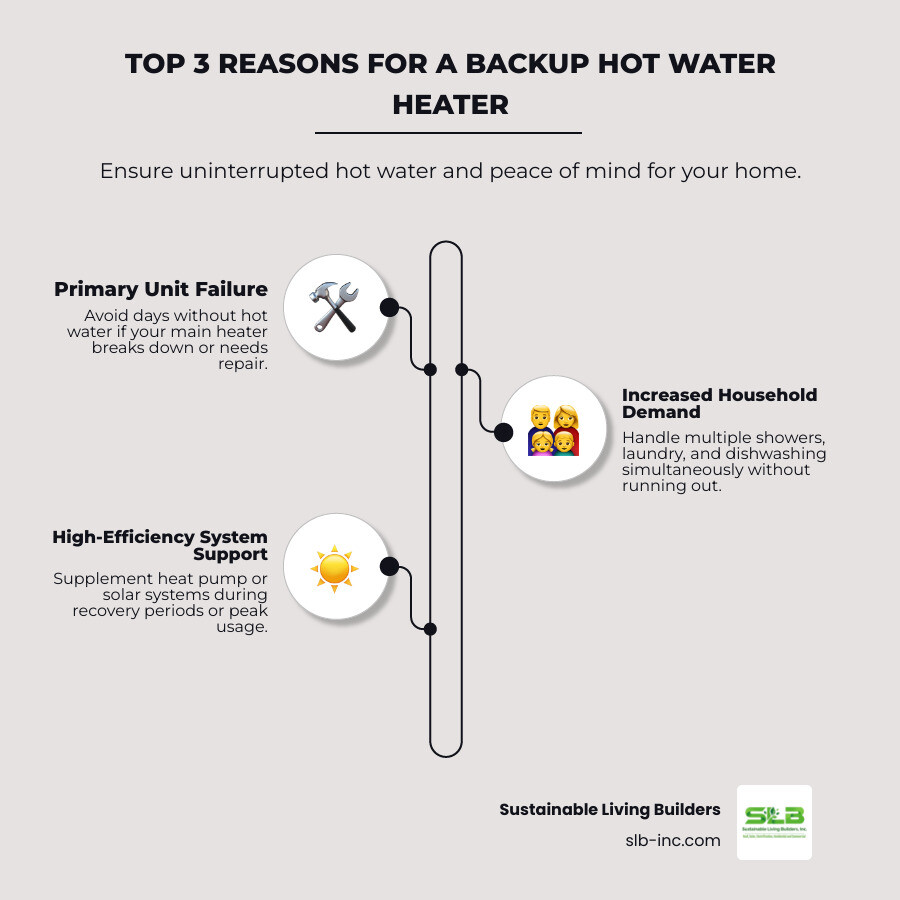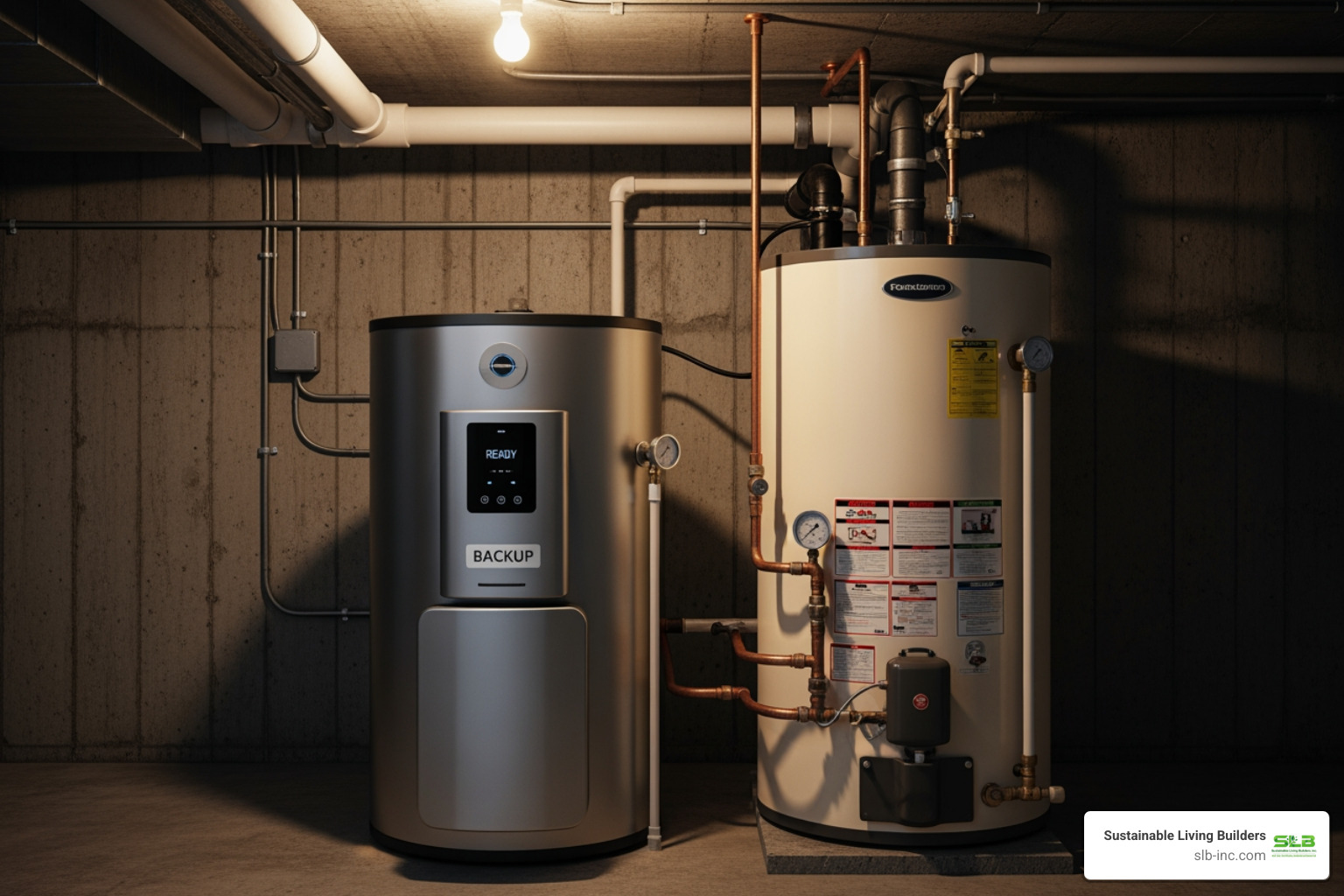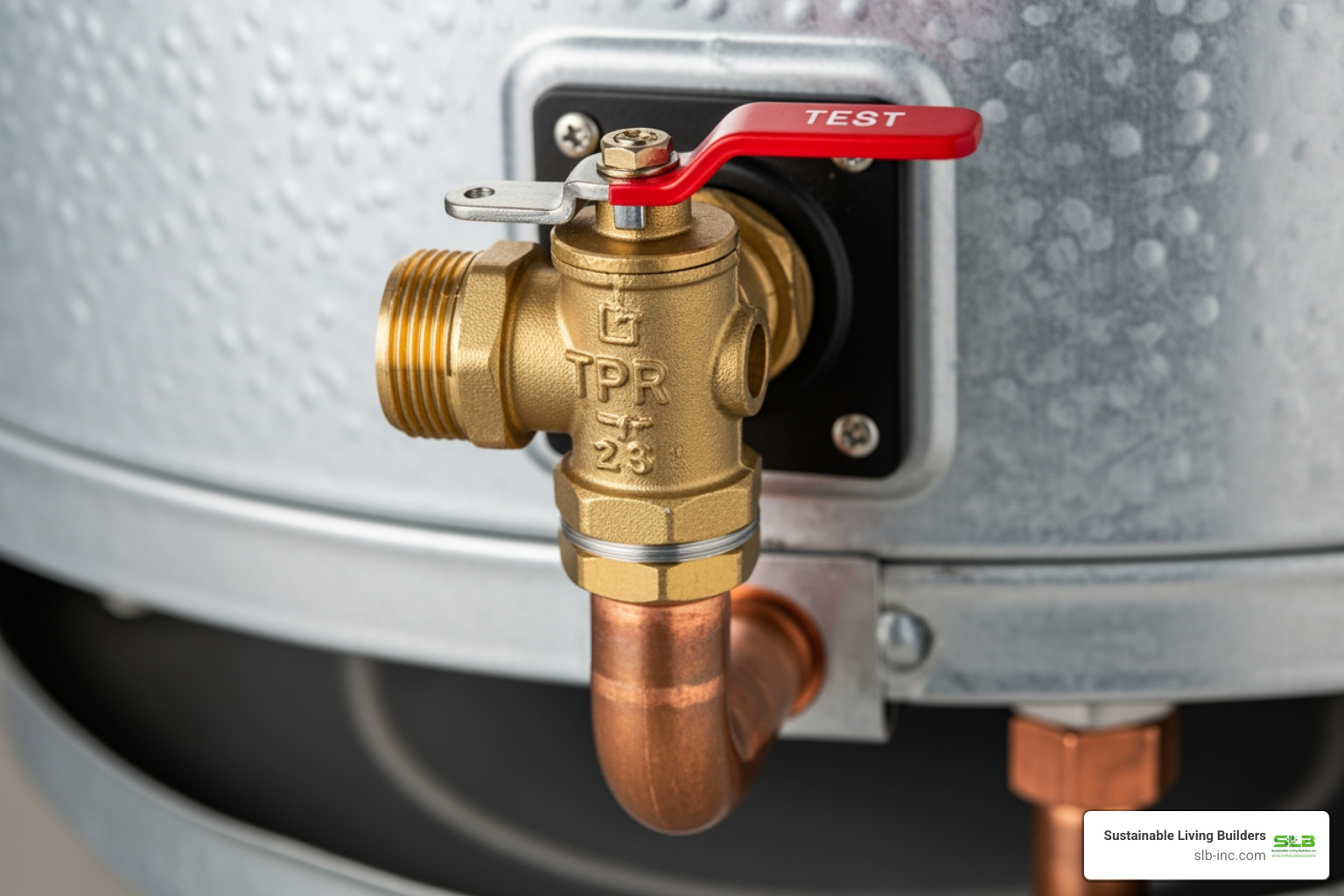Why a Backup Hot Water Heater Matters for Your Home
A backup hot water heater is a secondary system installed alongside your primary unit to ensure you never run out of hot water. It provides a continuous supply during peak demand or if your main equipment fails.
Top 3 Reasons to Install a Backup Hot Water Heater:
- Primary Unit Failure – Avoid days without hot water when your main heater breaks down.
- Increased Household Demand – Handle multiple showers, laundry, and dishwashing simultaneously.
- High-Efficiency System Support – Supplement heat pump or solar systems during their recovery periods.
Running out of hot water is frustrating, but a complete heater failure can leave you cold for days. A single water heater often can’t keep up with growing families, rental units, or even high-efficiency heat pump systems that can max out after just a couple of showers.
A backup hot water heater solves this by adding redundancy and capacity. Whether it’s a tankless unit, a smaller storage tank, or an integrated solar system, you’re investing in comfort and peace of mind. This guide covers configurations, sizing, installation, and maintenance to help you design a resilient hot water system.
For sustainable home improvements that reduce energy bills, explore our full range of services. Ready to ensure your home has a reliable hot water supply? Contact Sustainable Living Builders for expert guidance.

Why You Might Need a Backup Hot Water Heater
Imagine stepping into a cold shower because your main water heater failed and a replacement part is days away. This disruption is a primary reason homeowners consider a backup hot water heater.
Primary unit failure can happen unexpectedly. When a critical component fails, you lose one of your home’s most essential services. A backup system keeps your household running smoothly while you wait for repairs.
Beyond emergencies, many homes simply outgrow their single water heater. Increased hot water demand from a growing family, an extra bathroom, or a rental unit can overwhelm your system. A heater that worked for two people may not support a family of four, especially with high-efficiency models like heat pumps that can max out after just two showers.
High-efficiency systems also benefit from support. Heat pump water heaters, while 3-4 times more efficient than traditional models, have slower recovery times. Solar water heaters need a reliable backup for cloudy days or high usage periods. A backup hot water heater ensures these eco-friendly systems deliver consistent performance.
A backup system provides redundancy for a critical home system. Like backup power, a secondary water heater offers plumbing peace of mind, ensuring hot water is always available for showers, dishes, and laundry.
Exploring Backup Hot Water Heater System Configurations
Choosing a backup hot water heater means designing a system that integrates with your existing setup, fits your home, and meets your efficiency goals. Whether you need to save space, maximize efficiency, or ensure redundancy, there’s a configuration for you.

Series vs. Parallel: Understanding the Plumbing
Dual heater setups are connected in series or parallel, each serving a different purpose.
- Series Configuration: Water flows through the backup heater first, then to the primary heater. This “booster” setup is ideal for pre-heating water, which helps your main unit (like a heat pump) recover faster during peak demand. A small tankless unit placed upstream can warm incoming water, so the primary heater works less.
- Parallel Configuration: Both heaters connect independently to the water lines. This provides true redundancy. If one unit fails, you can shut it off and use the other without interruption. This failover capability requires proper shutoff and bypass valves to isolate one unit for maintenance while the other provides hot water.
Using a Tankless Heater as a Backup
A tankless unit is an excellent, efficient backup hot water heater, especially if space is limited. These compact, wall-mounted units provide on-demand heating, which eliminates standby heat loss and can be up to 34% more efficient than tank models. With proper care, they can last up to 20 years. However, consider the flow rate and gas or electrical requirements. Larger models may need dedicated circuits, while gas units require proper venting.
Integrating a Smaller Tank Heater as a Backup
A smaller tank heater offers a straightforward way to add a water storage buffer. A 4-gallon point-of-use unit, for example, has lower installation complexity and can serve a single sink or act as a small backup. While compact, these units still have some standby heat loss and require physical space. For safety, maintain tank temperatures at 140°F to prevent Legionella risk (using blending valves at taps) and perform regular anode rod maintenance to prevent corrosion.
Pairing with High-Efficiency Systems (Heat Pump & Solar)
High-efficiency systems work even better with the right backup.
- Heat Pump Water Heaters: These are 3-4 times more efficient than traditional heaters but can have slower recovery times. A backup hot water heater supplements their capacity during peak use, ensuring consistent hot water.
- Solar Water Heaters: These systems need a reliable electric backup for solar to handle cloudy days and nighttime demand. Integrated systems with stainless steel solar tanks often include built-in electric elements that activate automatically when needed.
Pairing your high-efficiency system with a backup makes it more practical for daily life. At Sustainable Living Builders, we design integrated systems that balance efficiency and real-world performance.
Key Installation and Sizing Considerations
Installing a backup hot water heater requires careful planning to ensure it works for your household and meets safety requirements in Sonoma, Marin, and Napa Counties.

Professional installation is essential. Water heaters involve complex plumbing, electrical, and gas lines. A professional ensures the system meets local building codes and safety standards, which is key to long-term performance and protecting your home.
How to Size Your Backup Hot Water Heater
Proper sizing depends on whether the unit is a booster or a full failover system. A booster only needs to handle partial demand, while a failover must cover all your household’s needs. Consider your household size and simultaneous water usage. For a flow rate calculation, add up the gallons per minute (GPM) of fixtures you might use at once (e.g., a shower is ~2.5 GPM). Also, cold incoming water temperature in Northern California winters means your heater must work harder, affecting its output. Many manufacturers offer online sizing calculators to help with these calculations.
Plumbing, Venting, and Electrical Requirements
Technical details are critical for safety and efficiency. For pipe materials, we typically recommend durable PEX and copper piping. Gas units require proper venting to prevent carbon monoxide buildup; this involves choosing between condensing vs. non-condensing vents. The electrical amperage needs for electric units vary greatly. Small point-of-use heaters may plug into a standard outlet, but larger tankless models often require dedicated circuits or even a panel upgrade.
Energy Efficiency and Recirculation Pumps
Consider your system’s overall efficiency. Tankless units offer on-demand efficiency by eliminating the standby heat loss common to tank heaters. To get hot water faster and reduce water waste, you can add a recirculation pump. However, to avoid constant energy use, control the pump with timers, manual switches, or smart recirculation systems that activate on demand. While great for convenience, their primary benefit is comfort and reduced wait times rather than massive water savings.
Safety and Maintenance for Combined Systems
With both a primary and backup hot water heater, consistent safety checks and maintenance are crucial for smooth, long-term operation.

Critical Safety Checks for Your Backup Hot Water Heater
Simple checks can prevent serious problems. Here’s what to look for:
- Legionella Prevention: For tanked systems, keep the water at 140°F to kill bacteria, and use blending valves at faucets to deliver a safe 120°F.
- Temperature & Pressure Relief (TPR) Valve: This critical safety feature prevents dangerous pressure buildup. Test it annually by lifting the lever to ensure it discharges water. The proper TPR discharge piping must run downwards to within 6 inches of the floor and remain unobstructed.
- Carbon Monoxide Prevention: For gas heaters, ensure proper ventilation by regularly checking the flue for blockages or damage. Venting issues are a life-threatening hazard requiring immediate professional attention.
- Gas Shutoff Valve: Ensure your gas heater has a clearly accessible shutoff valve for emergencies or maintenance. A missing or damaged valve is a serious safety risk.
Long-Term Maintenance for Dual-Heater Setups
Regular maintenance keeps your primary and backup hot water heater running efficiently. Key tasks include:
- Flushing Sediment: Annually flush tanked heaters to remove mineral buildup, which improves efficiency and prevents corrosion.
- Inspecting Anode Rods: Check the sacrificial anode rod in tanked heaters each year and replace it if it’s heavily corroded. This simple step can add years to the tank’s life.
- Descaling Tankless Units: Annually descale your tankless heater, especially in hard water areas, to remove mineral deposits that reduce efficiency and flow.
- Checking for Leaks: Regularly inspect all pipes, connections, and the base of tanked units for any signs of moisture.
- Verifying Valve Operation: Periodically test all shutoff and bypass valves to ensure they operate smoothly and aren’t seized.
- Cleaning Heat Pump Vents: Keep the air intake and exhaust vents on heat pump water heaters clean and clear to maintain proper airflow and efficiency.
These tasks take just minutes but provide priceless peace of mind. Sustainable Living Builders can help with professional maintenance for your system.
Frequently Asked Questions about Backup Water Heaters
Can a tankless heater provide instant hot water?
This is a common misconception. Tankless heaters provide endless hot water on demand, not instantly. They heat water as it flows, but you still have to wait for that hot water to travel through the pipes to your faucet. This delay can be a minute or more for distant fixtures. To get hot water faster, recirculation systems can reduce wait times by keeping warm water in the pipes, but they should be used with timers or smart controls to avoid wasting energy.
Can I install a backup water heater myself?
While DIY projects can be rewarding, we strongly advise against it for a backup hot water heater. Professional installation is recommended because the work involves complex plumbing, gas lines, and electrical work. A professional ensures the installation complies with local safety codes and permits in Sonoma, Marin, and Napa Counties. Improper installation can void warranties and create serious safety hazards like water damage or carbon monoxide leaks.
Does a backup system use a lot of extra energy?
Not necessarily. Energy use depends on the system type and configuration.
- Tankless backups only use energy on demand. They remain dormant until needed, so they don’t consume energy when your primary heater is working.
- Tanked backups have standby heat loss, but this can be minimized. Choose a well-insulated tank (R-24 or higher) and use smart controls to keep the water at a lower temperature until it’s needed.
A well-designed backup hot water heater system provides security without a major increase in your energy bills, aligning with sustainable living goals.
Conclusion
A backup hot water heater delivers more than just increased capacity—it provides genuine peace of mind. It protects you from sudden equipment failure, meets the demands of a growing family, and supports high-efficiency systems like heat pumps.
For homeowners in Sonoma, Marin, and Napa Counties, a backup system is a practical investment in a sustainable and resilient home. It turns a potential vulnerability into a reliable asset, ensuring you always have hot water when you need it.
At Sustainable Living Builders, we specialize in creating integrated, eco-friendly solutions. We can help you design a backup hot water heater system that works seamlessly with your existing setup, from solar panels to heat pumps.
Ready to make your hot water supply more resilient? Learn about our approach to sustainable home improvements at What services does Sustainable Living Builders Inc. offer?, or reach out to discuss your project.
